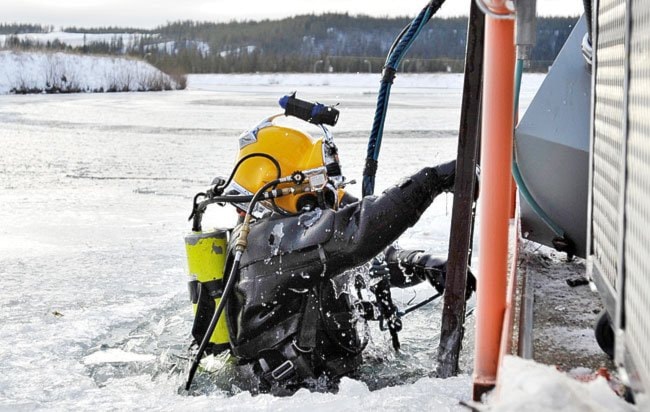Scuba divers have been hard at work under the frigid Yukon River waters in recent days to remove ice blocking the intake to Whitehorse’s hydro generators.
Yukon Energy believes that the jam was caused by a mixture of mild temperatures and strong winds.
“It essentially caused some slushy sheets of ice to come away from the shoreline on Schwatka Lake,” said spokesperson Janet Patterson. “They moved to the north end of the lake and towards our operation.
“The slushy ice literally wrapped itself around what we call our trash rack. Trash racks are essentially metal grates that prevent debris like branches, that sort of thing, from getting into our turbines.”
The ice completely blocked the intake to three turbine units and partially blocked the fourth, forcing a complete shut down of the hydro power station.
“I don’t believe that we’ve ever had a situation like this where we’ve had icing to the point where we’ve lost all of our units,” said Patterson.
Whenever intake to the turbines is blocked, the extra water is diverted and spilled into the Yukon River so the water doesn’t get backed up behind the dam, she said.
That occurred in this case, and diesel generators kicked in to fill the gap in power demand.
Yukon Energy has spent $192,000 on diesel as a result of the jam since the problem started Saturday evening, said Patterson.
On Sunday evening Yukon Energy flew up four scuba divers with ITB Subsea from Vancouver to deal with the problem.
They cleared the ice by diving down to the 12-metre-high intake grates and slowly melting the jam away with steam wands.
The third turbine was cleared on Monday.
The fourth turbine, the largest, was only partially blocked and when water was allowed to run through it, the ice cleared itself.
The remaining two intakes were cleared on Tuesday.
“This is a really good example of why the Yukon territory does need some kind of thermal backup,” said Patterson. “We don’t like to use diesel, we don’t like to use natural gas for generation, but in a case like this it really was a lifeline. Because if you think about it, Yukon Energy lost all our hydro capacity in Whitehorse, and yet not one person lost their power as a result.”
Yukon Energy is in the process of building an LNG facility for two new natural gas generators, set to replace aging diesel units.
If those generators had been up and running when this happened, it would have saved $34,000 in fuel costs, said Patterson.
Contact Jacqueline Ronson at
jronson@yukon-news.com
